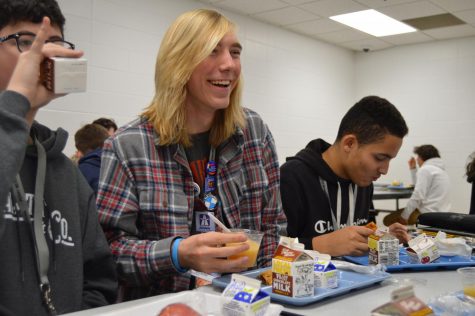Shared motifs: Comparisons between fall holidays
The evolution of Halloween has drastically changed from the original concept that came from the Irish: dressing up in scary costumes to ward away ghosts and lighting bonfires.
For Americans, the holiday has turned into dressing up and participating in trick-o-treating, watching scary movies, going on hay-rides, going to haunted houses and even throwing Halloween parties.
According to history.com, The Celts, an ethnic group in Europe, had the festival of Samhain in which they celebrated the end of harvest season. The festival was on November 1st, later turning into All Saints Day.
The Celts believed that winter was cold, dark and depressing, associating it with death and ghosts. Since the festival took place during near the start of Winter, it began to take up a scary connotation.
According to timeanddate.com, immigrants from Scotland and Ireland brought Halloween to the United States. It wasn’t until the 1900s where it began to become commercialized.
In the 1930s, Halloween costumes started appearing in stores. The tradition of ‘trick or treating’ came along in the 1950s.
Senior and native from Burma, Isaac Hnin, didn’t know anything about Halloween until he came to America back in 2009.
“There weren’t many holidays that my family celebrated,” says Hnin. “The only holiday we celebrated was Christmas.”
It wasn’t until the next year, in 2010, that Hnin celebrated Halloween for the first time with his cousins, all of them dressing up as ninjas. Although being from Burma, Hnin has grown accustomed to American holidays.
“I think in my culture Halloween is interpreted as a bad thing,” says Hnin. “All the decorations of monsters and so on… The Chin community, mostly Christians, they assume that it’s like the devil’s holiday.”
South Korean exchange student Wonny Chang has Halloween back home but it isn’t the typical trick-o-treating done here.
“We usually have some party,” says Chang. “We give some candy to kindergarten students, and some college students wear costumes.”
Chang spent a year in Michigan during elementary school, giving him his one and only opportunity to celebrate the holiday as he doesn’t celebrate when he is in South Korea.
Day of the Dead:
Dia de los Muertos, also known as Day of the Dead, originated from the Aztecs in Mexico; it is celebrated all throughout Latin America, trickling into America as migrants have brought their traditions with them.
These customs are passed down from generation to generation. The purpose of this day is for families to gather to honor and remember deceased loved ones.
For Freshman Judith Cruz, she grew up knowing little about the Day of the Dead, despite it being a big part of her culture.
Migrants, such as her parents, often lose traditions such as this day once they come over as they don’t see it as something important.
Cruz, herself believes it is an important aspect in her culture and would like to learn more about it.
“It connects us to our culture and as a tradition it should be carried on and accepted more,” says Cruz
Sophomore Natalia Alvarado has celebrated Day of the Dead in a traditional way. Her family set up the traditional altar with pictures of her passed loved ones along with their favorite foods and things they liked.
“On November 1st, we would bring them flowers and those that died as kids, we would bring toys and balloons for them,” says Alvarado.
The Day of the Dead also goes into November 2nd, where for Alvarado and her family, they celebrated going to a mass dedicated to their passed loved ones, where they then bring flowers to their graveyards along with their favorite foods and as a family they gather up and eat those foods.
Later that day, they ate a bread called “Pan de Muerto” and drink it with hot chocolate or “atole”.
On this day, it is believed that the souls of those who have passed return to visit their living families in their homes, businesses and cemeteries. It’s a day in which we welcome back the memory and the souls of those people who are still an important part of the family, even though they are not physically present. For Americans, recognizable aspects are sugar skulls and skeletons.
However, for hispanic people it means more than just “Spanish Halloween”.
The altar, or ofrenda in Spanish, embodies the spirit of the celebration. A typical ofrenda consists of a set of items that will identify the person to whom it is being dedicated, such as: photographs, personal items and favorite foods.
As well as traditional dishes such as a pan de muerto, a traditional sugary pastry covered with skull shapes. The food choices have more to do with the deceased taste and traditional culture and it represents a way to remember our loved ones by sharing a meal with them as one would when they were alive.
The ofrenda is also adorned with marigold petals to guide ancestors home with its bright colors. They are most commonly constructed on a surface with a tablecloth and papel picado, which is made of tissue paper cut in patterns.
In many communities, the ofrenda can turn from an object into a full event, in many cases the whole community will be involved.
Unlike Halloween, Day of the Dead is not meant to be a sad or frightening day, but an uplifting time to remember loved ones who have passed away. To many hispanics, it’s a sacred day in which a lot of people pray. It is a day meant for remembrance and honoring the impact that a family member left while they were still alive and keeping their memory alive.



